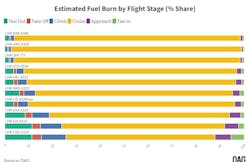Which part of a flight uses the most fuel?
BOSTON - It may be some time since many of us have taken a commercial flight but we don’t forget that feeling of being pushed back into our seat as the pilot put the aircraft into full throttle as the aircraft started to accelerate along the runway. As the plane starts to lift we can believe the engines are working their hardest and burning the most fuel. While take-off may be the most intense point of a flight in terms of fuel consumption, is it right – as some of us have been led to believe – that this uses more fuel than any other part of the flight? Becca Rowland writes for OAG. Continue reading original article.
The Military & Aerospace Electronics take:
9 Feb. 2022 - OAG Labs utilized data from 10 flights that departed from London Heathrow Airport to a variety of destinations, including a short hop to Paris in an Airbus A319 and a long haul to Hong Kong in an A350. The other flights were to Athens (ATH), Dubai (DXB), Edinburgh (EDI), Geneva (GVA), Helsinki (HEL), Lisbon (LIS), Madrid (MAD) and New York (JFK).
"Total fuel burned is an important metric, but so too are those around efficiency," Rowland writes. "Aircraft capacity, age and engine type all contribute significantly to relative fuel burn. In our example, the A380 used to fly to Dubai uses almost 14 liter of fuel per kilometer flown while the newer A350 to Hong Kong uses just 6.0, less than the A319 to Paris. Meanwhile the A321neo, one of the newest aircraft, uses an average of 2.7 liters of fuel per kilometer."
OAG's experiment used nine aircraft from Airbus and one 777 from Boeing and measured fuel burn in six segments: taxi out, take off, climb, cruise, approach, and taxi in.
Related: Former Airbus exec says aviation industry needs to embrace alternate propulsion
Related: In-flight 100% sustainable-fuels emissions study of passenger jet shows early promise
Related: S-92 helicopter completes first flight using biofuel
Jamie Whitney, Associate Editor
Intelligent Aerospace
